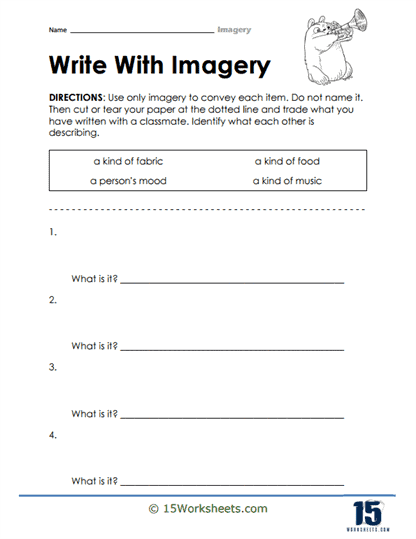

These worksheets help you understand and practice the use of imagery in writing. Imagery is a literary device that uses sensory details to create vivid mental pictures and evoke sensory experiences in the reader’s mind. It helps make writing more descriptive, engaging, and memorable.
To explain imagery, let’s take an example – Imagine reading a sentence that says, “The sun dipped below the horizon, painting the sky in shades of orange and pink.” This sentence creates a visual image in your mind by describing the colors and actions of the sun and the sky. It helps you imagine the scene as if you were there, seeing it with your own eyes.
This set of worksheets provide exercises and activities that help you recognize and analyze imagery in texts. These worksheets often contain passages or sentences where you have to identify sensory details, visualize the described scenes, or create your own imagery.
By working on imagery worksheets, you can:
Identify Imagery – Imagery worksheets help you develop the skill of recognizing imagery in writing. By reading sentences or passages, you learn to identify sensory details that appeal to your senses of sight, sound, taste, touch, and smell. This skill allows you to appreciate the power of descriptive language in creating mental images.
Visualize Scenes – Imagery worksheets encourage you to visualize the scenes and experiences described in the writing. By focusing on sensory details, you imagine the sights, sounds, tastes, smells, and textures being described. This practice enhances your ability to create vivid mental pictures and immerse yourself in the narrative.
Understand Descriptive Language – Imagery worksheets allow you to explore the use of descriptive language in writing. You learn how authors use words and phrases to create sensory experiences and evoke specific emotions. By understanding imagery, you gain insight into the techniques writers employ to make their writing more engaging and captivating.
Enhance Writing Skills – By learning about imagery, you enhance your own writing skills. Imagery provides you with tools to make your writing more descriptive and vivid. By practicing imagery through worksheets, you develop the ability to incorporate sensory details into your own writing, making it more engaging and memorable.
Appreciate the Power of Language – Imagery worksheets foster an appreciation for the power of language to evoke emotions and create mental pictures. You recognize how descriptive language can transport you to different places, evoke specific moods, or make you feel connected to the story. This awareness helps you appreciate and analyze the use of language in literature and everyday communication.
Authors use imagery in their work for several reasons:
Creating Vivid Mental Pictures – Imagery allows authors to paint vivid mental pictures in the minds of their readers. By using descriptive language and sensory details, authors can transport readers to different places, scenes, or moments. Vivid imagery helps readers visualize the story, characters, and settings, making the narrative more engaging and immersive.
Eliciting Emotional Responses – Imagery has the power to evoke strong emotional responses in readers. By appealing to the readers’ senses and emotions, authors can create a deeper connection between the story and the reader. Descriptive imagery can make readers feel a range of emotions, such as joy, fear, nostalgia, or awe, enhancing the overall impact of the narrative.
Enhancing Descriptions – Imagery adds depth and richness to descriptions in literature. By using sensory details, authors make their descriptions more vivid and memorable. Readers can imagine the sights, sounds, smells, tastes, and textures being described, creating a multi-dimensional experience that brings the story to life.
Engaging the Senses – Imagery appeals to the readers’ senses, making the reading experience more immersive. By incorporating sensory details, authors stimulate the readers’ senses of sight, sound, taste, touch, and smell. Engaging the senses allows readers to form a deeper connection with the narrative and experience the story on a more sensory level.
Creating a Memorable Reading Experience – Well-crafted imagery makes a story more memorable. Readers are more likely to remember vivid scenes, characters, and moments that are described with rich sensory details. By using imagery effectively, authors leave a lasting impression on readers, making the story more impactful and unforgettable.
Conveying Themes and Symbolism – Imagery can be used to convey themes, symbolism, or deeper meanings in literature. Through carefully chosen sensory details, authors can express abstract ideas, evoke symbolic associations, or convey subtext. Imagery allows authors to communicate layers of meaning beyond the literal level of the story.